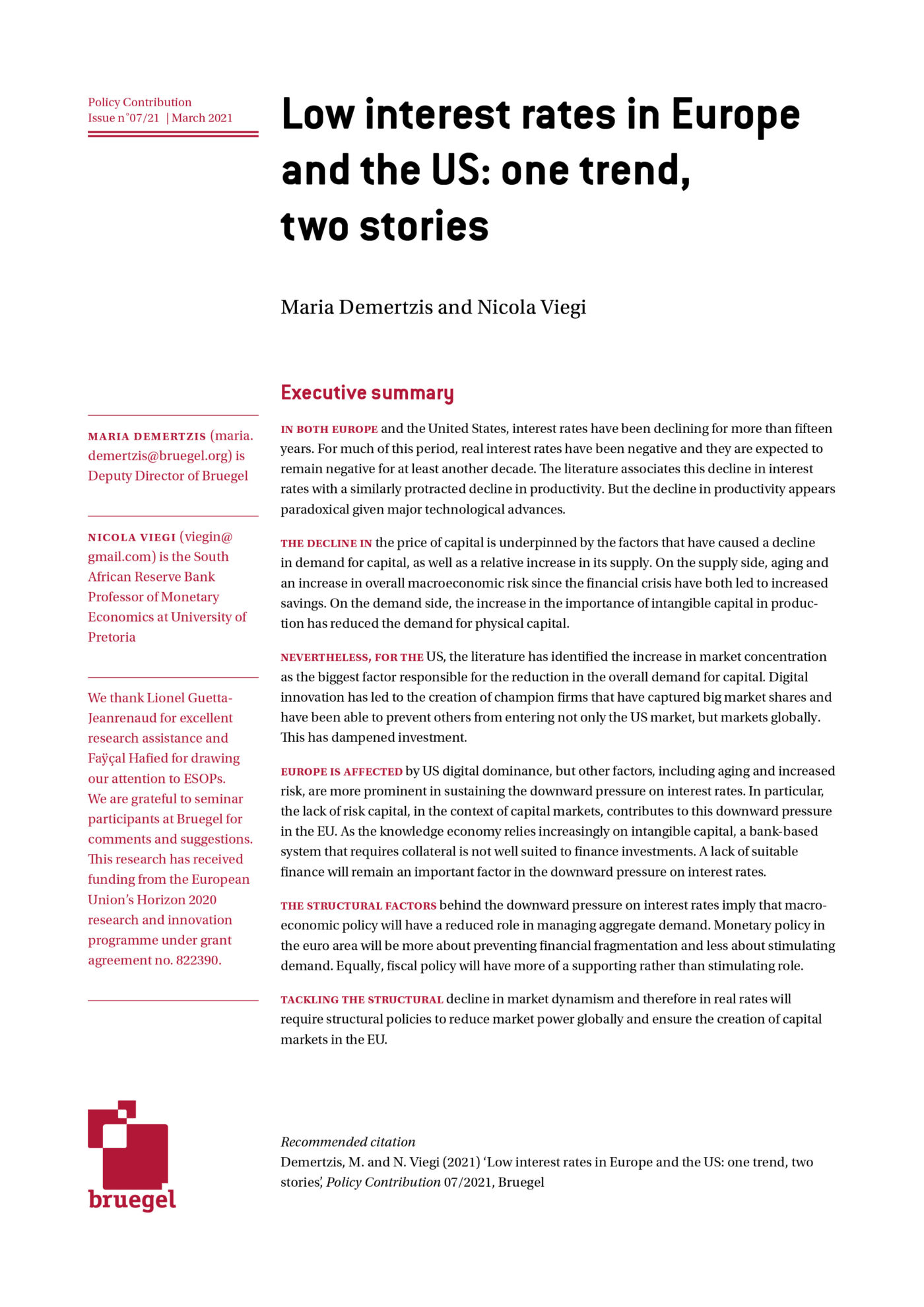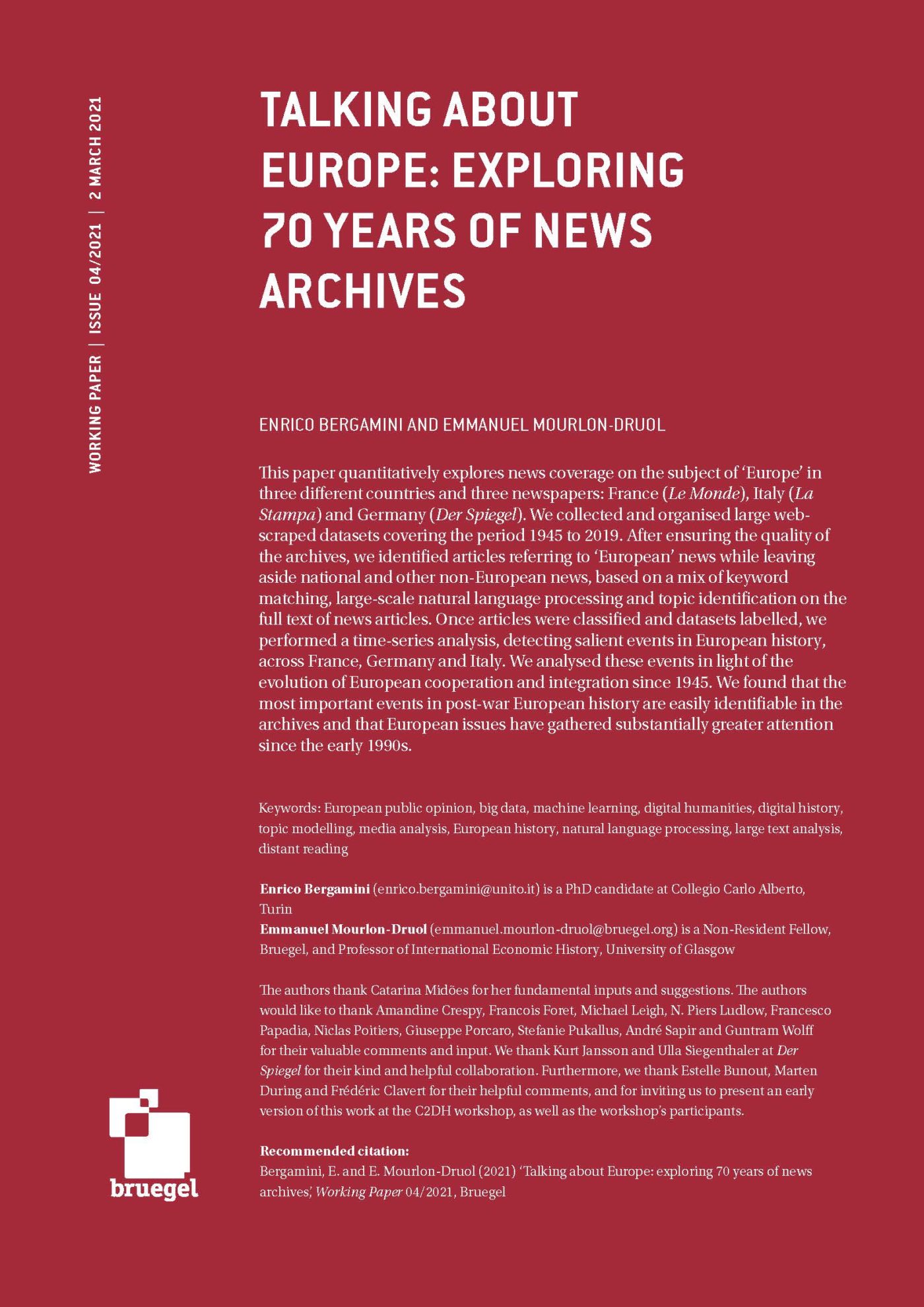Blog Post
Talking about Europe: Le Monde 1944-2018
An ongoing research project is seeking to quantify and analyse national printed media discourses about Europe over the decades since the end of the second world war. A first snapshot screened more than 2.8 million articles in Le Monde, out of which 750,000 speak about “Europe”.
One way to contribute to the debate over whether there is a fledgling pan-European public opinion is to measure whether there is an increasing trend of media mentions about European matters in national printed press.
The complexity of identifying and measuring such a European public opinion has been already considered in a past Policy Contribution, which pointed towards divergences in national narratives over the reporting of the euro-crisis. However, there are historical, long-term patterns that have not been explored as yet.
Our ongoing research is focusing on how, over the decades since the end of the second world war, media coverage of European issues has changed, arguably corresponding to the changing interest of their readership
Our ongoing research is focusing on how, over the decades since the end of the second world war, media coverage of European issues has changed, arguably corresponding to the changing interest of their readership. This is just a first step in a more refined analysis, which could give further indications about divergence or convergence patterns between national media.
Printed press is the only possible source of data for the long period to be covered by the analysis, so only newspaper and magazine articles will be considered as a proxy for measuring the level of public debate at European level. The desire to cover a very long period of time also dictates the choice to target the analysis only at the six founding members of the EU. Furthermore, in order to limit the heavy data-collection burden, the analysis will concentrate – for the time being – on the three largest founding members: Germany, France and Italy.
More in the hope of provoking a discussion than of providing conclusive results, this post presents preliminary estimates of the ratio of “European” news versus the total number of news pieces (E/T) for the French newspaper Le Monde. There are important caveats to be taken into account in looking at these results. The ratio between the European and the overall total numbers of articles was calculated by dividing the number of articles that are defined as European by the total number of articles for the specified time period – namely, monthly and yearly. For instance, in the overall period from 1944–2018, there were 2.8 million articles in Le Monde, out of which 750,000 could be classified as European.
For each entry in the dataset, we queried a number of keywords that are (or have been, historically), associated with Europe. For Le Monde, the keywords selected are: “Europe”, “Union européenne”, “UE”, “Communauté économique européenne”, “Communauté européenne”, “CEE”, “Commission européenne”, “Parlement européen”, “CECA”, “CEEA / Euratom”, “Schengen”, “Euro”, “Maastricht”, “BCE”, “Banque centrale européenne”, “Bruxelles”, “Strasbourg”, “européen”, “Marché Commun”, “instances européennes”, and “Commission de Bruxelles”.
If any of these keywords matched the words in the article, this was counted as European. This is a first exploratory technique applied on the raw dataset, which still counts news pieces that are not in the political, economic or social sphere, such as sports or current events. A more refined analysis will classify articles according to their nature and exclude those in these latter kinds of categories.
Figure 1: Ratio of European news to total news in Le Monde archive (1944-2018)
Two phenomena emerge from Figure 1:
- A regular increasing trend over the seven decades in the chart: in the 1940s, European news represented some 15–20% of the total news, whereas from 2000 onward the share is 35–40%. While the results need checking and cleaning, it is unlikely that the trend will disappear;
- There are significant and sustained ups and downs in the E/T ratio around the increasing trend.
A first check of the plausibility of the results is to see whether the ups and down around the trend can be explained by specific historical events. For this purpose, some representative local peaks and troughs are identified and the events connected to them are specified in Table 1 below. Two of them are then analysed in greater detail.
A first interesting observation is that the elections to the European Parliament – in June 1979, 1984, 1989, 1994, 1999, 2004, 2009 and 2014 – clearly correspond to local peaks. In addition, local peaks are also contemporaneous to some important events – for instance, the rejection in 1954 of the European Defence Community; French president Charles de Gaulle’s vetoes of UK applications to join the EEC; the negotiations to create the European Monetary System (EMS); the French decision to stay in the EMS; and the French referendum on the Maastricht Treaty, as detailed in the timeline.
Timeline: Historical events connected to the peaks and troughs in the European/Total ratio of article examined
A more granular analysis of two examples, covering almost two years of time, confirms the plausibility of the E/T ratio.
The years 1961 and 1962 provide a first case study. The ratio’s peaks closely follow the evolution and fate of discussions related to the project of setting up a European political union. The meeting of the EEC members’ heads of government in Germany in July 1961, when they confirmed their intention to create a politically united Europe, contributes to explaining the peak at 22% (up from 20% the previous month). The ratio goes down before reaching a new peak in October 1961 (24%), when the first Fouchet plan for political union was put forward. The ratio drops slightly again (22%), but then rises in December 1961 and January 1962, corresponding to the submission of the second version of the Fouchet plan (23%, January 1962). The ratio then goes back to 22% and stagnates until June 1962, when it reaches a peak of 29%. This is when President de Gaulle of France acknowledged the breakdown of discussions of political union, and criticised supranational integration (press conference on May 15th 1962).
The negotiations about the creation of the EMS in 1978 provide another case study, further highlighting the plausibility of the calculated E/T ratio. Between January and December 1978, three peaks stand out: the European Council in Copenhagen in April (which marks the start of the EMS discussions; the ratio is up at 22%), the European Council in Bremen (when the EMS negotiations become more concrete; the ratio is up at 24%), and the European Council in Brussels (when the EMS is agreed upon, and a few days later Ireland and Italy join; the ratio is up to 27%).
It is noticeable that the entry into force of the EMS, in March 1979, corresponds to an E/T trough (at 25%). The negotiations over the scheme were more important than the entry into force per se, and hence more likely to be discussed in the press. This is well reflected in the evolution of the ratio.
Also, the decrease in the E/T ratio starting in 2004, culminating in 2009 and ending around 2012, is remarkable: the reflection of the financial crisis, as evidenced by the E/T ratio, seems to have emerged only during the euro-area sovereign debt crisis and not in its first, sub-prime phase.
While stressing again that the presented data are still preliminary and limited to one specific newspaper in a single country, the following conclusions seem to emerge from this first exercise:
- The clear positive trend of the E/T ratio is consistent with the hypothesis that there is a growing European dimension to national public debates. The argument of a missing European public opinion in Europe as an obstacle to further integration is, at least as far the results of Le Monde show, losing ground decade after decade – even if the point about a necessary balance between the degree of integration and the vibrancy of a European public opinion is still valid.
- A relative measure, such as the one presented in Figure 1, cannot answer the question of whether the degree of integration achieved so far, as well as any further possible progress, is consistent with the level of “Europeanisation” of public opinion that is currently prevailing.
- The positive trend of the E/T ratio reflects the ever-greater centrality of EEC/EU-related issues in the national public debate. At one level this is logical: EEC/EU competencies have gradually increased over time, and so they come up more frequently and in greater ‘quantity’ in the news. But the actual reflection of this in the news could not have been taken for granted.
- The E/T ratio shows a quite regular increase, it is not just the ‘big summits’ and big events that are reported in the press; EEC/EU-related issues are ever more often entering the national debate.
- The ups and downs in the E/T ratio are, in most cases, contemporaneous to significant historical developments, thus giving credence to the plausibility of the ratio.
The further work on the source of Le Monde data – as well as the extension to a German and an Italian newspaper/magazine, and a more granular quantitative and qualitative analysis – will allow the determination of whether these tentative conclusions can be confirmed.
Republishing and referencing
Bruegel considers itself a public good and takes no institutional standpoint. Anyone is free to republish and/or quote this post without prior consent. Please provide a full reference, clearly stating Bruegel and the relevant author as the source, and include a prominent hyperlink to the original post.











